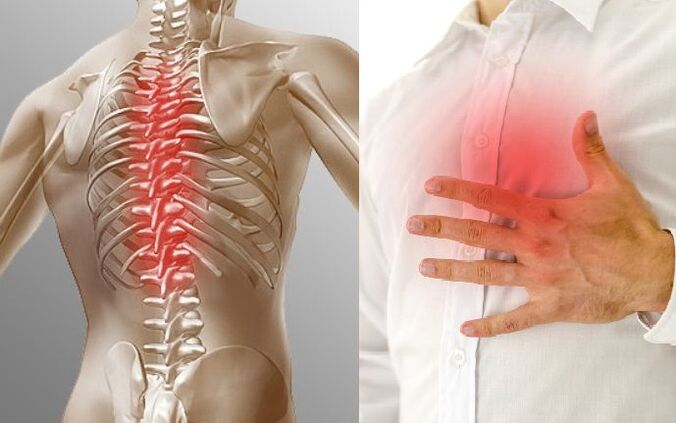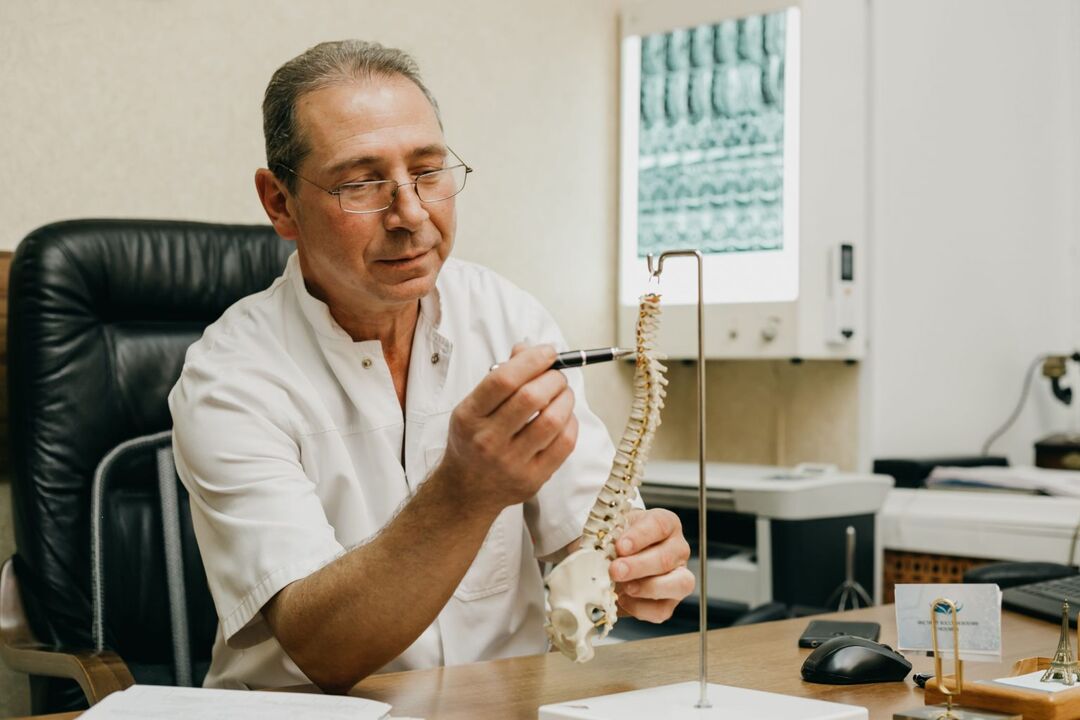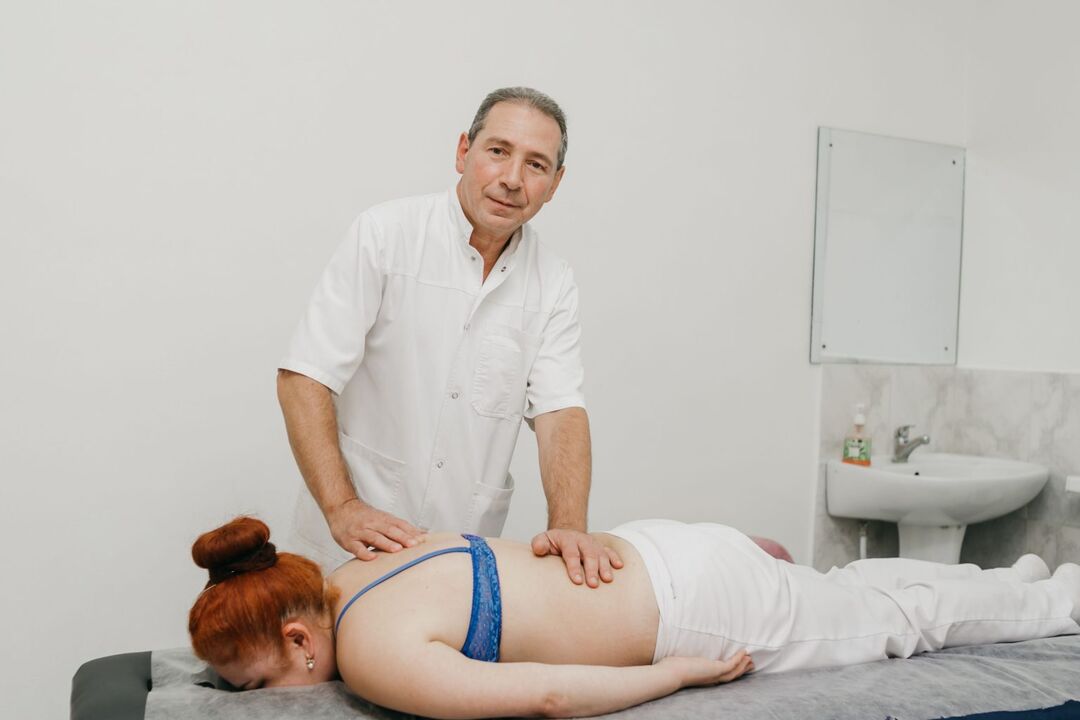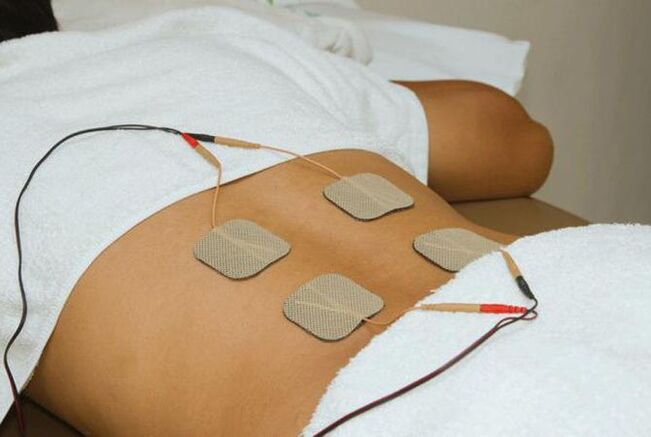Osteochondrosis, as the most common disease of the spine, today occurs in people of completely different ages, although not so long ago it was considered an exclusively age-related disease.It is characterized by the occurrence of degenerative-dystrophic changes in the intervertebral discs, which lead to pain and create the conditions for the formation of bulges and hernias.The disease can affect any part of the spine, but osteochondrosis of the thoracic region is extremely rare.This leads to significant difficulties in diagnosis, since the symptoms of the disease mimic pathologies of the cardiovascular system.However, if a diagnosis is made, it is important to immediately begin treatment for thoracic osteochondrosis.Failure to do so may result in extremely serious complications and reduced performance.
A doctor's report
“Since there are a number of nerve endings in the intervertebral discs, any change in their structure leads to the transmission of corresponding signals to the brain, resulting in pain in the affected area.”

What is thoracic osteochondrosis and features of its treatment?
Osteochondrosis of the thoracic spine occurs in less than 10% of all cases diagnosed with this disease.This is due to the low mobility of the thoracic spine.However, this is the main insidiousness of thoracic osteochondrosis, since its symptoms are in many ways reminiscent of signs of diseases of the cardiovascular system.Therefore, patients often first turn to a cardiologist or other specialist and undergo treatments that do not bring results, only to see a neurologist when the disease has already progressed.
There are 12 vertebrae in the thoracic spine.There are intervertebral discs in between, but more often the first and last movement sections of the spine in this department are affected by osteochondrosis.
In the future, the situation may be complicated by compression of the spinal roots, which emerge from the spinal cord in pairs at the level of each vertebra and are responsible for regulating the function of the lungs, internal organs of the abdominal cavity and pelvis.The result is dysfunction and pain that radiates to the ribs, the so-called radicular syndrome.
In general, thoracic osteochondrosis can manifest itself:
- Pain in the shoulder blades that increases with deep inspiration;
- pain behind the breastbone in the heart area;
- the appearance of cough, shortness of breath due to the development of bronchitis, bronchial asthma, pneumonia and other diseases of the lungs and bronchi;
- Pain in the right hypochondrium, which is due to disruption of the liver, gallbladder and its ducts and may be due to the development of cholecystitis, metabolic disorders, etc.;
- Pain in the left hypochondrium or shingles due to pancreatic dysfunction, leading to an increased risk of developing diabetes;
- reduced immunity, occurrence of allergic reactions due to suppression of the innervation of the adrenal glands;
- Urinary tract diseases due to renal dysfunction and additional infectious diseases, especially pyelonephritis;
- Diseases of the female and male genital organs, including infertility.
In this case, severe pain triggers reflex tension in the back muscles, which causes unpleasant sensations there and increases the risk of pinching of the nerve structures.
The risk of changes in the function of internal organs increases sharply in the later stages of the development of thoracic osteochondrosis, when there is already protrusion of the intervertebral discs, i.e.h.the formation of protrusions and intervertebral hernias is observed.In such situations, the pathological protrusion leads to compression of the nerve roots, which leads to disruptions in the innervation of the corresponding internal organs and the development of their diseases.
Although thoracic osteochondrosis is a relatively rare disease, it can affect the functioning of the entire body.Therefore, immediate initiation of comprehensive treatment is necessary.To do this, you need to contact a neurologist who will assess the patient's condition, study the available examination results and develop an individual treatment program.This largely depends not only on the degree of thoracic osteochondrosis (there are 4 stages, of which the 1st is the simplest), but also on the nature of the manifestations of the diseases, the type of concomitant diseases present, age and a number of other factors.Therefore, the treatment of patients with approximately the same degenerative changes in the intervertebral discs can have significant differences if the approach is correct.

Treatment of thoracic osteochondrosis is always complex.The aim is to solve the following problems:
- Elimination of unpleasant symptoms of the disease, thereby improving the patient's quality of life and restoring full functionality;
- Improving blood circulation in the affected area, thereby activating metabolic processes and facilitating regeneration processes in the intervertebral disc;
- Elimination of the causes of osteochondrosis;
- Reducing the likelihood of complications of the disease.
For this, patients may be prescribed the following:
- correction of lifestyle;
- drug therapy;
- exercise therapy;
- manual therapy;
- traction therapy;
- physiotherapeutic treatment.
The attending physician decides which specific methods are recommended to the patient depending on the severity of the degenerative-dystrophic changes in the spine.So, if thoracic osteochondrosis is diagnosed in the 1st stage of development, which unfortunately happens quite rarely, it is usually enough to limit yourself to certain lifestyle adjustments, exercise therapy and manual therapy.
However, if the disease has already progressed to the 2nd and especially the 3rd stage, additional drug therapy, traction therapy, etc. is definitely recommended.In addition, if osteochondrosis has already led to the formation of intervertebral hernias, especially large ones, and is accompanied by severe radicular syndrome that cannot be eliminated using conservative methods, only surgery can achieve an improvement in the patient's condition.
Therefore, treatment for thoracic osteochondrosis, as well as similar lesions in other parts of the spine, is aimed at stopping the further progression of degenerative changes in the intervertebral discs and improving the patient's well-being.With existing lesions, especially large ones, complete restoration of the cartilage tissue, not only of the intervertebral discs but also of all other joints, is not yet possible.So, let's look at the main methods of treating thoracic osteochondrosis and their features.
Correction of lifestyle
After diagnosing thoracic osteochondrosis, the doctor strongly recommends making certain changes to your usual lifestyle.If a patient shows signs of excess weight, he is advised to take measures to reduce it.But all weight loss diets, especially single-component diets, are contraindicated.The diet must be complete and varied so that the body receives all the substances necessary for proper functioning and the metabolic processes in the intervertebral discs occur properly.Therefore, it should correspond as fully as possible to the principles of rational nutrition.
It is also recommended that all patients increase their physical activity, especially those who lead a sedentary lifestyle.This can be daily walking, swimming, yoga or Pilates.However, serious physical activity, especially intensive training on simulators, jumping sports and weight lifting, are contraindicated.

If the patient's job involves heavy physical work, such as heavy lifting, it is advisable to try a change.This is due to the fact that increased loads on the back in the presence of osteochondrosis can act as a trigger for the rapid progression of degenerative changes in the intervertebral discs.
Absolutely all patients with thoracic osteochondrosis are recommended to change the mattress to an orthopedic mattress of medium hardness and purchase an orthopedic pillow.This ensures that the physiological curvatures of the spine are maintained and further degeneration of the intervertebral disc is prevented.
Drug treatment of thoracic osteochondrosis
When treating osteochondrosis, patients are usually prescribed a complex of medications.Some of them are recommended to be taken only occasionally, especially in case of exacerbation of the disease, while others should be used in courses, the duration of which is determined by the doctor.
When prescribing certain medications, the neurologist must clarify whether the patient has concomitant diseases and their nature. This is necessary in order to exclude contraindications to taking certain medications.
In general, the following groups of drugs can be prescribed for thoracic osteochondrosis:
- NSAIDs;
- corticosteroids;
- muscle relaxants;
- vitamins;
- chondroprotectors;
- topical products;
- Means for improving microcirculation.
NSAIDs
Nonsteroidal anti-inflammatory drugs are one of the most extensive groups of drugs, as they have a large list of indications, which includes thoracic osteochondrosis.They have anti-inflammatory and analgesic properties and are therefore indicated for exacerbations of the disease and the appearance of pain.
Today there are 4 generations of NSAIDs, of which the latest 4th generation drugs are considered the safest and most effective.They are characterized by their selective effect and have almost no negative effect on the mucous membranes of the stomach and duodenum.At the same time, previous drugs in this group should not be used for gastritis and gastric and duodenal ulcers, especially for a long period of time, as they can lead to their exacerbation.
NSAIDs are available in almost all possible dosage forms, so you can choose the drug depending on the method of use.Therefore, in the early stages of thoracic osteochondrosis, the use of ointments, gels or creams is indicated.If the pain is more severe, capsules or tablets are preferred; if there is no effect, intramuscular injections of medication are allowed.
Corticosteroids
Drugs in this group belong to the hormonal group and contain synthetic analogues of adrenal hormones.Therefore, they have a strong anti-inflammatory effect and are indicated for severe inflammatory processes.However, due to the possibility of a number of negative side effects, they are most often prescribed in the form of injection solutions and only in short courses.
In addition, corticosteroids are used in combination with local anesthetics to perform paravertebral blocks.They are indicated for very severe pain that impairs the ability to work, but can only be carried out in a medical facility.Blockades help to quickly relieve even very severe pain and consist of introducing a prepared solution into points in the immediate vicinity of the spine, in the area of the passage of the spinal roots.
It is recommended to carry out such procedures no more than four times a year.
Muscle relaxants
Muscle relaxants are a group of medicines used to relieve muscle spasms.Let's remember that they often act as the body's reflex reaction to pain.Therefore, the use of muscle relaxants helps reduce the severity of pain in thoracic osteochondrosis.
Vitamins
In the treatment of thoracic osteochondrosis, vitamin complexes with increased amounts of B vitamins can also be prescribed.This is necessary to improve the quality of conduction of bioelectric impulses along the nerves, which is especially important in radicular syndrome.In this way, the development of dysfunction of the organs innervated by the spinal roots of the intervertebral discs at the level of the lesion is prevented.
Chondroprotectors
Chondroprotectors are a relatively new group of drugs that are actively prescribed for thoracic osteochondrosis.As active ingredients, they predominantly contain compounds that are completely natural for the human body and are used by it to regenerate intervertebral discs and other cartilage.
However, at the same time, there is still no convincing evidence of the effectiveness of drugs in this group in advanced forms of osteochondrosis, although they work quite well in the initial stages.At the same time, the natural origin of the chondroprotectors ensures a high level of safety.
These medicines are available in various forms including capsules, topicals, powders and solutions for injection.The best results are observed with the administration of injectable chondroprotectors.However, despite all the positive aspects of the drugs in this group, they are characterized by high cost, which, together with the need to use them in courses of 30 days or more, makes their use not accessible to everyone.
Current products
In addition to the ointments, creams and gels containing NSAIDs and chondroprotectors discussed above, the treatment of thoracic osteochondrosis may include the use of warming and local irritating agents.Their principle of action is based on the irritation of the skin receptors at the application site.This leads to active blood circulation in the area of application and thus to a supply of nutrients.This improves the nutritional quality of the intervertebral discs and reduces pain.
Products to improve microcirculation
Drugs in this group are also used to improve blood circulation and activate metabolic processes.
Movement therapy
Therapeutic physical education plays one of the leading roles in the treatment of thoracic osteochondrosis, as it allows:
- strengthen the muscle corset, which ensures high-quality support of the spine;
- normalize muscle tone;
- Activate blood circulation, which improves the metabolic processes in the affected intervertebral discs.
However, patients should be aware that the use of general exercises can have a negative impact on the course of the disease and well-being, since they do not take into account individual characteristics, the degree of osteochondrosis and existing concomitant diseases.Therefore, for effective treatment of thoracic osteochondrosis, it is necessary to develop an exercise therapy program individually.

In order for the patient to master the correct exercise technique, it is recommended to initially train under the supervision of an exercise therapy instructor.He will be able to correctly calculate the load according to the level of physical development of a person and adjust his movements so that the exercises performed bring the greatest possible benefit.The program gradually becomes more complicated and after it has been fully mastered, the patient can practice at home.However, in order for classes to give good results, they should be carried out daily.
In all therapeutic exercises, it is important to avoid sudden movements.
Manual therapy for thoracic osteochondrosis
One of the most effective methods of treating thoracic osteochondrosis is manual therapy, as it allows you not only to train the muscles well, but also to influence the spine.This is where it differs from therapeutic massage, which is also very useful for osteochondrosis, but cannot have the same effect as manual therapy because it does not involve the spine.
However, in order for manual therapy to bring only benefits, one must be careful when choosing a specialist to carry it out, because the effect on the spine must be precise.Otherwise there is a high risk of complications.
Manual therapy sessions begin with stroking and relaxing the muscles.The doctor works well on each area of the back, eliminating spasms and preparing the soft tissues for more active action.He then begins to use mobilization and manipulation techniques, which can sometimes involve mild discomfort and grinding.
The method of manual therapy deserves special attention, which is characterized by the use of special techniques that have proven themselves to be one of the most effective over the course of 20 years.They not only allow a positive effect on the affected intervertebral discs, but also improve the quality of functioning of all internal organs, since, as mentioned above, they have a close relationship with the spine.

In general, a manual therapy session provides the following:
- Restoration of the correct anatomy of the spine by returning the vertebrae to their assigned places;
- Increasing the distance between the vertebral bodies, which has a positive effect on the condition of the intervertebral discs by reducing the pressure exerted on them;
- normalization of muscle tone;
- Elimination of functional blockages;
- Improving the function of the lungs, bronchi, heart and gastrointestinal tract;
- Strengthening immunity and reducing exposure to allergens.
At the same time, an improvement in well-being can be observed after the first session.The patients then notice a progressive reduction in pain and an improvement in their general condition as well as an increase in performance and mood.
Physiotherapy
To treat thoracic osteochondrosis after the completion of the acute stage of the inflammatory process, physiotherapeutic methods are often used.They can further reduce the severity of back problems and also have a number of other positive effects on the body.
Most often, the following are prescribed for thoracic osteochondrosis:
- Electrophoresis with introduction of drugs – this method allows deeper penetration of the drug components into the tissues and enhances their therapeutic effect through the use of a weak electric current;
- Magnetotherapy is a method of physiotherapeutic treatment based on the beneficial effect of a magnetic field on the body, stimulating blood circulation in the area of influence, which leads to the activation of metabolic processes, a reduction in pain and swelling.
- Laser therapy is a method that allows you to achieve a pronounced anti-inflammatory and vasodilating effect, which also leads to an improvement in the condition of the intervertebral discs and pain relief.
- Ultrasound therapy is a physiotherapeutic procedure that has an anti-inflammatory and analgesic effect;
- Diadynamic currents are an effective method of physical influence, the use of which leads to a reduction in the intensity of pain, an increase in the metabolic rate and an improvement in the condition of muscle tissue.
Physiotherapeutic interventions are usually prescribed in courses of 10-15 sessions.But each of them has its own contraindications that must be taken into account when choosing a specific type of exposure.

Traction therapy
Traction therapy allows you to increase the distance between the vertebrae of the thoracic spine, thereby reducing pressure on the intervertebral discs affected by osteochondrosis.This stops the progression of the disease and creates optimal conditions for the restoration of cartilage tissue.Traction therapy or spinal traction is carried out on a special table under the supervision of a medical professional.
Although thoracic osteochondrosis is not a common disease, it can significantly reduce a person's quality of life and lead to the development of a number of pathologies of internal organs.At the same time, the difficulty of diagnosis has a negative impact on the patient, as degenerative changes in the intervertebral discs continue to worsen without appropriate treatment.As a result, complications often arise in such situations, including the formation of bulges and intervertebral hernias.Therefore, it is important not to ignore changes in well-being and immediately consult a doctor and, when diagnosing thoracic osteochondrosis, strictly follow the recommendations received from him.





















